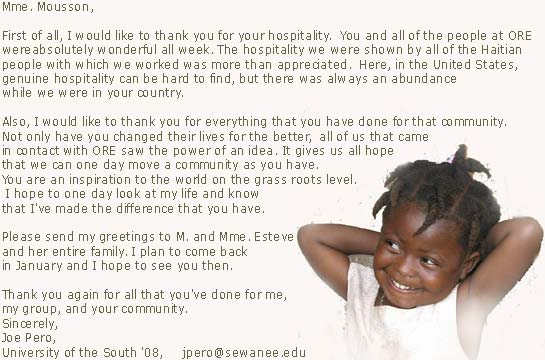ORE is a non-profit NGO, established in Haiti in 1985, and in Florida in 1986, to improve environmental, agricultural and economic conditions in rural Haiti by promoting high revenue tree crops, improved seeds, and marketing programs.
What people are saying about ORE
Over the years we have collected a number of testimonials.




Mike Benge, Senior Forestry Advisor (USAID), USDA Forest Service, writes about ORE
The Organization for the Rehabilitation of the Environment (ORE) that is affiliated with ORE-Haiti, does an excellent job working to improve environmental, agricultural and economic conditions in rural Haiti with high-value tree crops, improved seeds, cash crops and marketing programs.
ORE was established by Sean Finnigan, a horticulturalist living in Camp Perrin, in the south of Haiti. He saw the potential economic and environmental benefits of grafted fruit trees for Haitian farmers and set out to introduce high-value trees as a permanent feature of the Haitian agricultural system. [Website: http://www.oreworld.org/ : Email: mail@oreworld.org ).
Mike Benge
Senior Forestry Advisor (USAID)
USDA Forest Service
International Programs
1099 14th Street, NW Suite 5500W
Washington, DC 20005
Tel (202) 501-3025
Fax (202) 273-4750
email: mbenge@fs.fed.us
Norman C.Bezona, Professor Emeritus, University of Hawai'i, Tropical Agriculture, writes about ORE
I have worked with ORE in cooperation with Peace Corps since 1999 on the bamboo project. The goals of this project were to introduce elite species of bamboo that could be used in Haiti for construction, crafts and food as they are used in tropical Asia.
Sean Finnigan, his family and team at ORE have been truly the most enjoyable and effective NGO with which I have worked in the past 20 years. With limited funds they have managed to sustain a relatively stable community in a country that has and continues to go through extremely difficult political and economic times. Although I focused on the bamboo project, I could not help but be impressed with ORE's successes in quality seed production for farmers, improved tropical fruit production, environmental education and reforestation.
I would be there right now working with ORE if the political climate allowed. As things improve, we in Hawaii hope to share more bamboo species and expertise with a country and people that have great potential given the opportunity. In times when most would have given up hope, the Finnigans have shown their metal by remaining true to the task. Sean you have been a true model of strength and courage for me and many others here.
Norman C. Bezona, Professor Emeritus, University of Hawaii, Tropical Agriculture.
Emeritus Extension Agent in Hawaii Institute of Tropical Agriculture and Human and Resources
Paul Paryski, former UNDP Chief Technical Advisor, and Environmental Governance Consultant writes about ORE
Successes are rare indeed in Haiti, a country on the verge of violent and chaotic collapse. ORE is a rare exception. With its innovative, synergistic approach to environmental restoration, based on improving the plight of Haiti's impoverished peasant farmers, ORE has made a difference, changing the landscape of southern Haiti.
After analyzing the economic reasons that force peasant farmers to destroy his environment to simply survive, and understanding the complexities of Haitian peasant culture, ORE has devised a program of agro-ecological techniques to both improve farmers revenues and repair damaged, highly eroded watersheds.
The ORE program includes training in grafting high revenue fruit species to existing trees, providing highly productive fruit tree seedlings such as improved and off-season mango and avocado varieties, providing useful bamboo's, distributing high quality seeds, integrated pest management, reforesting critical areas and promoting terrace agricultural systems.
ORE's program is so successful that it has difficulties meeting demand. If any NGO working in Haiti deserves support, it is ORE.
Paul Paryski
former UNDP Chief Technical Advisor
Environmental Governance Consultant
Member of New Mexico Governor Richardson's Blue Ribbon Water Task Force
Conservation Chair, Northern New Mexico Group of the Sierra Club
Dr. Felix Prinz zu Löwenstein, Prince Löwenstein,
Board Member of Naturland, a worldwide organic agriculture association, and President of BÖLW, an association of organic food producers and traders, based in Germany, writes about ORE
I have known the people of ORE and their work since the very beginning. I worked as a "volunteer" in Haiti in a project financed by the German catholic relief association MISEREOR from 1982 to 1985 and later I visited Haiti twice in the course of project evaluations.
The ORE approach is the only viable one: to take into account the capacities of the farmers and their actual situation and then offer solutions they can realize themselves with their own means. In a country where farmers work on slopes that are far too steep and where heavy rainfalls cause erosion, tree-planting is of vital importance. As arable land is extremely scarce and legal security of the farmers' land-ownership is very weak, "classic" reforestation programs fail regularly.
It is to ORE's credit that they have created incentives to conserve and even to plant new trees by grafting fruit trees (producing trees for farmers and teaching them to graft), by introducing new out-of-season varieties and by organizing the marketing of their products. Also the activities to strengthen sustainable and ecologically stable farming-systems on small scale farms are exemplary for good and effective help.
Such projects can only succeed when those who put them into action have long-term local experience, live among the people concerned and have an inner engagement for their needs.
I couldn't name another project among all those I have seen both in Haiti and in Africa I could recommend more for support than ORE in Camp Perrin!
Dr. Felix Prinz zu Löwenstein
Hofgut Habitzheim, D – 64853 Otzberg, Germany.
In German:
Ich kenne die Leute von ORE und ihre Arbeit seit den ersten Anfängen. Ich war von 1982 bis 1985 in Haiti als Entwicklungshelfer in einem Projekt des deutschen katholischen Hilfswerkes MISEREOR tätig und habe für Projektevaluierungen später Haiti noch zweimal besucht.
Der Ansatz von ORE ist der einzig mögliche: die Möglichkeiten der Menschen aufgreifen, ihre Situation berücksichtigen und ihnen dann Lösungen anbieten, die sie mit ihren eigenen Mitteln und Fähigkeiten selbst umsetzen können. In einem Land, in dem auf viel zu steilen Hängen gewirtschaftet werden muss und in dem starke Niederschläge die Erosion begünstigen, hat das Anpflanzen von Bäumen oberste Priorität. Da aber der Boden extrem knapp und das Bodeneigentum unsicher ist, eignen sich hierfür klassische Aufforstungsprojekte nicht. Es ist das Verdienst von ORE, durch Veredelung von Fruchtbäumen und die Organisation der Vermarktung den Anreiz geschaffen hat, trotz dieser Begrenzungen Bäume zu erhalten oder sogar neu anzupflanzen. Auch die Initiativen zur Stärkung nachhaltiger und ökologisch stabiler Anbausysteme in bäuerlichen Kleinst-Strukturen ist vorbildlich. Solche kleinen, aber höchst effektiven und langfristig wirksamen Projekte können nur Menschen gelingen, die jahrzehntelange Erfahrung vor Ort besitzen, ihr unter den betroffenen Menschen leben und damit engagiertes für deren Bedürfnisse eintreten. Ich wüsste keine Aktivität unter allen Entwicklungshilfeprojekten, die ich in Haiti und in Afrika kennen gelernt habe, die ich mehr für eine Unterstützung empfehlen könnte!
Dr. Felix Prinz zu Löwenstein
Hofgut Habitzheim, D – 64853 Otzberg
Haiti : A ravaged land more bleak
International groups spent millions of dollars to plant trees in Haiti but failed to slow the deforestation that leads to floods like the one that killed 3,000 people in Gonaives.
Source: Copyright 2004, Miami Herald
Date: December 26, 2004
Byline: SUSANNAH A. NESMITH
CAMP PERRIN , Haiti - Sean Finnigan travels the rutted mountain roads above this town, proudly pointing out ''his'' mango trees.
Finnigan is passionate about the mangoes he has persuaded area peasants to grow on their tiny plots. The trees are like his children. He loves them for the simple reason that they are alive.
In a country where maybe 50 million trees are felled every year, mostly to make charcoal, Finnigan's trees stand as small miracles in a landscape of catastrophe.
International organizations have poured millions of dollars into Haiti to try to slow the country's devastating deforestation, and they have little to show for it. Twenty years after reforestation efforts began in earnest, the mountains are barer, the trees scarcer. And the country's soil is still slowly sliding into the sea.
''We, all the aid organizations together, have planted about three million trees a year,'' said Jean André Victor, president of the Haitian Environment Foundation, noting that he was referring to seedlings that actually grew into trees. Experts estimate that only 30 percent of seedlings do.
''But 50 million trees are cut down every year,'' Victor added. ``That's why the forests have disappeared.''
The consequences of that were all too clear in Gonaives in September, when Tropical Storm Jeanne sent walls of mud and water raging through the city of 300,000 people. About 3,000 died as homes, livestock and businesses were washed away.
The reasons behind the failure of so many reforestation projects seem as numerous as Haiti's bald and barren hillsides.
Projects have been stymied by Haiti's crippling poverty, widespread corruption and recurrent periods of instability. Foreign development organizations brought their own problems to the table -- short-term goals that changed with the political winds in Washington or at the United Nations in New York and ill-conceived projects that tried to impose reforestation on wary peasants.
Then there is the perennial lure of charcoal, Haiti's primary fuel for home cooking and running bakeries and dry cleaners. Its smoke hangs in a heavy haze over cities like Port-au-Prince, and all over the countryside soot-bathed peasants can be seen making it.
It's why the peasants cut the trees, and no fuel is cheaper.
A RARE SUCCESS
All of that is why Finnigan, a native of London who has lived in Camp Perrin since the 1970s, loves his trees so much. Experts point to his 19-year effort to plant trees around Camp Perrin as one of the few reforestation successes in Haiti.
Finnigan's group, the Organization for the Rehabilitation of the Environment, began in 1985 with a simple strategy -- to turn native mango trees into moneymakers by grafting them with the Madame Francique strain, prized by U.S. importers.
''Back in those days, a lot of reforestation projects were with forestry trees,'' Finnigan said. ``But farmers want something that makes money.''
He secured $6.8 million from the U.S. Agency for International Development and other organizations over the years and even branched out into grafted avocados and oranges and fast-growing bamboo -- anything that would be more valuable to the peasants than the charcoal they can make when they cut down a tree.
TANGIBLE RETURNS
Finnigan estimates that the trees that his group helped plant earn $6.6 million every year, with much of that going to the hundreds of thousands of peasants who own them.
''If you can take an entire area and have them producing high-revenue crops in five years, they'll never look back,'' he said during a recent interview in his headquarters in this town 100 miles southwest of Port-au-Prince.
Mango grower Wilyo Pierre agrees. ''The people around this area, they don't cut [mango] trees anymore,'' Pierre said. ``Since people here found out about grafting, they see it's better than charcoal.''
The problem is not that the peasants don't want trees.
''We really need trees up here,'' said Jean-Robert Laurent-Pierre, 48, father of 11 and a peasant leader in the town of Robin in the mountains above Port-au-Prince. ``The deforestation is taking the soil with it, and the dry season is longer up here now.''
The barren mountains where he lives stand at the top of the watershed that ultimately empties into the capital. Floods in Port-au-Prince start in places like Robin.
''When I was little, there were a lot of trees like apples and peaches,'' Laurent-Pierre said. ``People cut them and never replanted them. The land has gotten so much worse. We used to produce a lot in the past. There used to be flat parts of the land. Now it's all ravine.''
But he admits that when his family has needed money, he has cut down trees for charcoal. ''We know it's bad, but we have to live,'' he said.
Finnigan's organization isn't the only group that turned to fruit trees to make money for the peasants. Experts now say that's the only viable option, because it's too late to try to replace native pine and mahogany forests.
'You can't say, `OK, we're going to put the forest back,' '' said Mike Bannister, a forestry professor at the University of Florida, who worked in Haiti for years. ``What are you going to do with all those people who live where the forest was?''
THE CORE PROBLEM
Bannister and Gerry Murray, a University of Florida anthropologist, worked on a project that gave peasants fast-growing trees that could be harvested for their wood and would grow back.
But even that project couldn't solve the larger problem of deforestation, largely because the Haitian government did not do enough to protect the existing watersheds. ''The problem is there's no government in Haiti,'' Murray said. ``They can't even collect the garbage.''
Murray blamed much of the problem on corruption. ``The only thing that the Haitian government has been hellbent on doing is getting as much money as it can in Swiss bank accounts.''
And then there is the basic failing of the foreign aid organizations -- almost always short-term efforts, at least when measured against the life of a tree.
Such projects ''usually succeed during the life of the project because people are being paid to plant trees or carry out anti-erosion measures,'' said Paul Paryski, a retired U.N. environmental expert, who spent nearly 20 years in Haiti. ``As soon as the money stops coming in on a project, the people abandon it and start cutting trees again.''
The Rev. Wilner Donecia, the parish priest in the town of Gros Morne in the mountains above Gonaives, remembers one foreign aid group that paid peasants to plant trees and install erosion control walls on their own plots.
''If you pay [the peasant] to fix his own land, he's going to destroy everything once you leave so you'll come back again and pay him again,'' he said.
In the end, the project did more harm than good, Donecia said, as other peasants denuded their land, hoping for pay to undo the damage.
Today, the hopes of reforestation programs are nearly spent.
The U.S. Agency for International Development is no longer financing reforestation in Haiti. The projects ended in 2001, after tainted elections led to an international aid embargo against the government of former President Jean-Bertrand Aristide.
SHORT SHRIFT
And the $1.3 billion aid plan cobbled together by foreign donors after Aristide was ousted last February allots only $8 million for environmental programs -- none of it for reforestation. The World Bank also is not financing any reforestation.
All that is left are the small projects like Finnigan's, which has planted or grafted about 830,000 trees in two decades. And he has had to cut back from 150 employees to 50 because he can't get financing.
And even though Finnigan's program is regularly praised as effective, catastrophe still threatens his headquarters area.
A local irrigation system built by French colonists in 1759 and restored in the 1950s by the Haitian government is on the verge of collapse. The Ravine du Sud river that feeds the system is choked with boulders and silt washed down from bald mountains where peasants have yet to plant mangoes.
Last year, the boulders and silt choked off the natural flow of the river and diverted it through Camp Perrin. After several days, Finnigan and other farmers used heavy equipment to unblock the river.
One of the mountains above the river is a national park, where there is not supposed to be logging or farming. But about 2,000 families are farming there.
''They're destroying the watershed for 600,000 people,'' Finnigan said. ``It's suicidal.''
A fix is planned for the irrigation system, but it is only temporary, and Finnigan expects that within five or six years, the whole system will be choked beyond repair. That would leave his mangoes without water and bankrupt the local economy.
''It's like we're building a sand castle and the tide is coming in,'' he said.
Originally posted at:
http://www.miami.com/mld/miamiherald/news/world/haiti/10499690.htm

Support our efforts to improve conditions in Haiti


